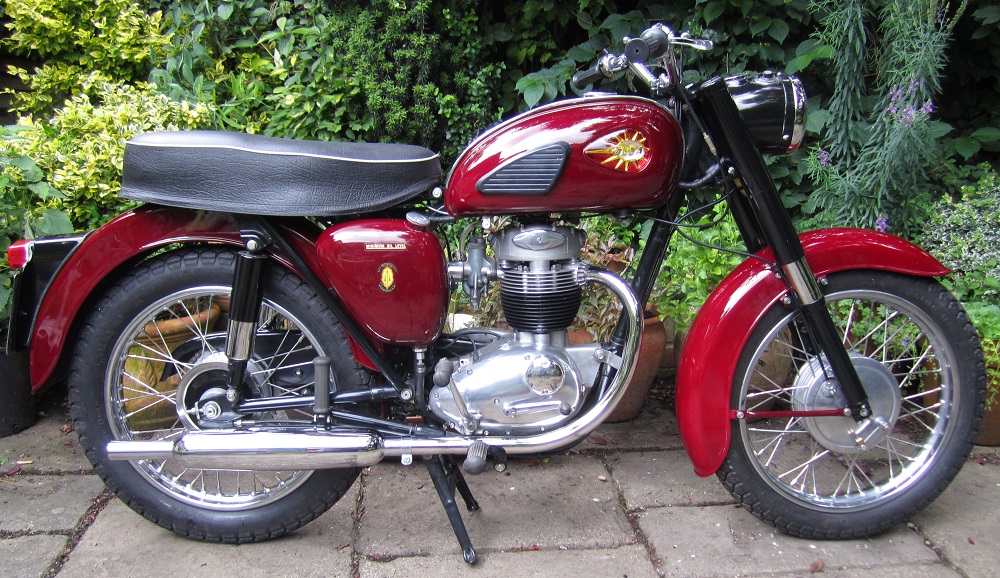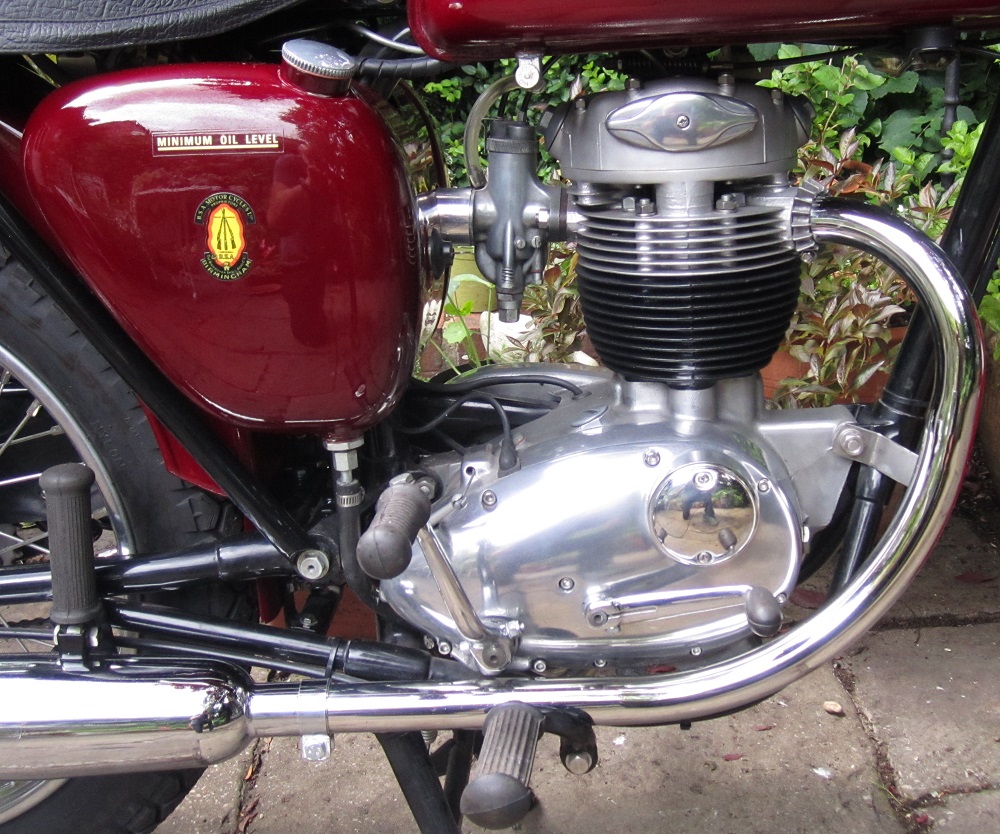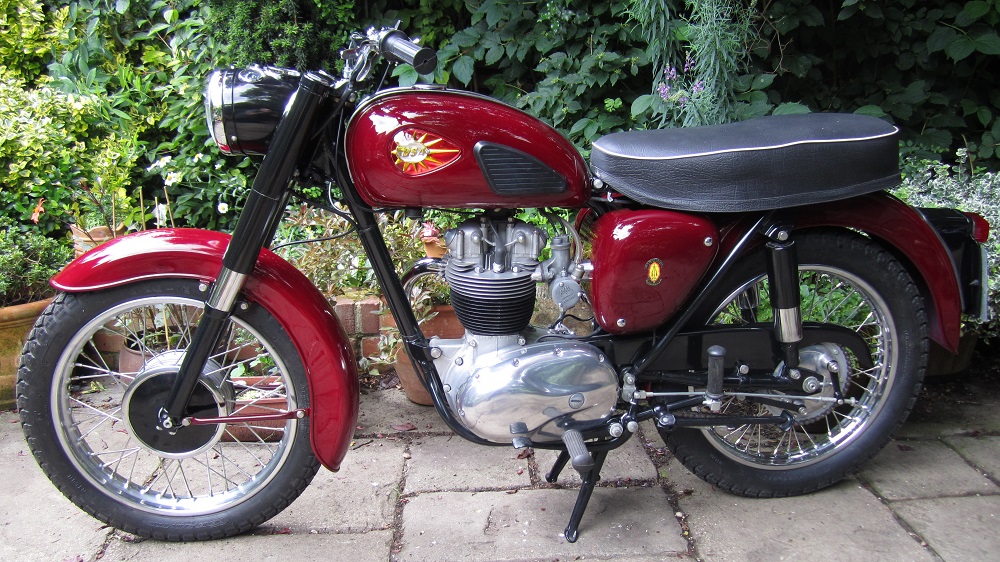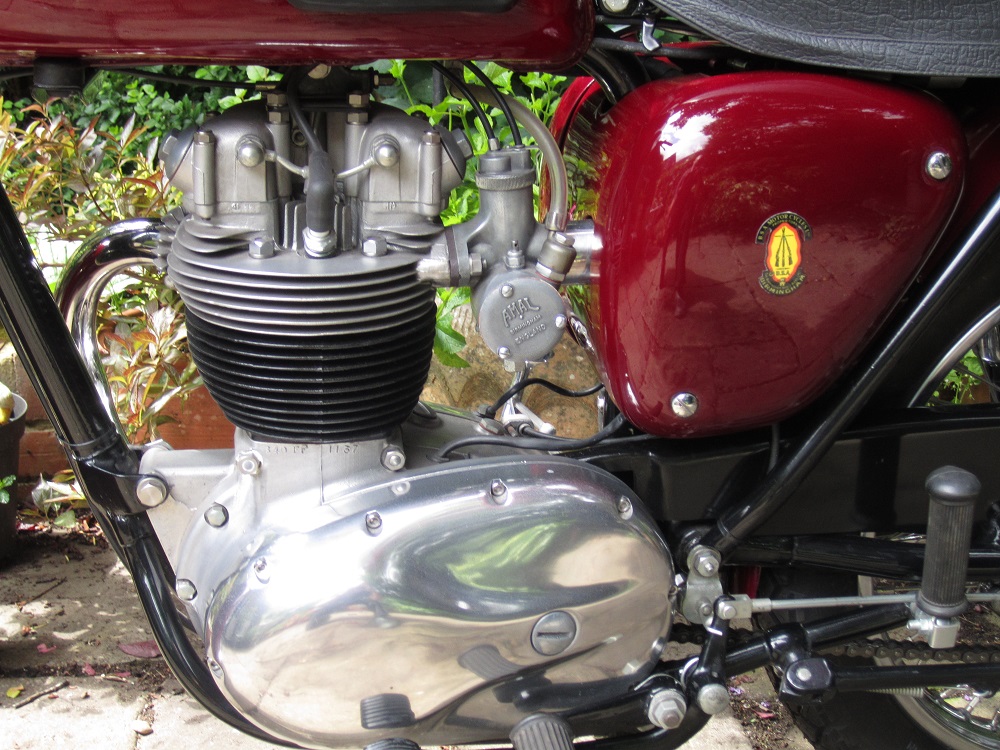The BSA B40 Star was a larger engined version of the C15 and was first produced during the 1961 model season continuing in production until the end of the 1967 season. It used the same 70 mm stroke as the C15 engine but the bore was increased from 67 mm to 79 mm to give a capacity of 343 cc. In terms of cycle parts, the main difference was that the B40 used larger 18″ wheels front and rear compared with the 17″ wheels on the C15.
The main distinguishing feature of the B40 engine was the absence of the C15’s chrome pushrod tube and a more bulbous looking cylinder. Instead of the C15’s pushrod tube, the B40 used a pushrod tunnel cast into the cylinder. The other main difference was the use of a an AMAL 276 Monobloc carburettor with 1 1/16″ choke to give greater engine power. The B40 engine was also fitted with a handlebar lever controlled decompressor allowing the exhaust valve to be opened to facilitate kicking over the engine although, with 7:1 compression ratio, this was hardly necessary. The engine originally used a plain big-end bearing but, like the C15, this was changed in 1963 to a roller big-end bearing. The other change occurred in 1965 with a change from a distributor to contact breaker points in the outer timing cover.
A more sportier version of the B40 was introduced in 1962 called the Sports Star or SS90. The engine used larger valves, a compression ratio raised to 8.75:1, an AMAL 389 Monobloc carburettor with 1 1/8″ choke size, and a sportier camshaft. The SS90 was distinguished from the B40 Star in using chromium plated mudguards and a separate headlight shell. The SS90 continued in production until the end of the 1965 season at which point it was replaced by the B44.
In 1964, a trials competition version of the B40 was introduced called the B40 Enduro Star. This used the welded/duplex frame adopted for the C15 competition model in 1963 and later used on the B40WD and B44. It was very similar in configuration to the later B44VS with an aluminium petrol tank and high level silencer. The B40 Enduro continued until the end of the 1965 season when it was replaced by the B44 Victor Enduro.
The only other B40 model introduced in the UK was a variant for the police produced in 1964 and 1965. This was essentially a B40 Star but without the chrome panels on the petrol tank.
The main commercial problem with the B40 was that its capacity of 350 cc was too large for leaners to ride but too small for those riders who had past their test and wanted something more powerful. Despite that, it was a very nice bike to ride with a useful amount of extra power (5 bhp) compared with the C15.
Although the B40 Star was discontinued at the end of the 1967 season, it continued after this date in the form of the Mk I B40WD used by the UK and various other armed services, and later on in MkII and Roughrider civilian forms. However, the B40WD version was actually a B40 engine in a later B25/B44 welded duplex frame and so bore little resemblance to the earlier B40 Star.
My B40 Star Restoration
I rode both a Triumph tiger Cub followed by a BSA C15 in the early 1970’s when I was living in West London. I enjoyed my C15 but always longed for a B40 because my friend rode one and I thought, wrongly as it turned out, that this was a much more powerful motorbike.
My 1965 B40 is actually an ex-Police motorbike and differed from the civilian version by not having chrome panels on the petrol tank. The original colour would have been all black which is the colour mine was painted when I first restored it. When I bought the bike about 15 years ago, it was in good running order but I gave it a full nuts and bolt restoration to bring it back to factory condition. The engine was fully rebuilt with new bearings and seals throughout, and a new piston and valves and springs. The primary chain was replaced as were the clutch friction plates and springs.




 The wheel hubs were powder coated silver and the wheels then rebuilt using new stainless steel spokes and chromed rims. New tyres and inner tubes were then added. The front forks were overhauled with new stanchions, bushes and seals. The rear shocks were beyond salvage and so were replaced by new units.
The wheel hubs were powder coated silver and the wheels then rebuilt using new stainless steel spokes and chromed rims. New tyres and inner tubes were then added. The front forks were overhauled with new stanchions, bushes and seals. The rear shocks were beyond salvage and so were replaced by new units.
The frame and brackets were all powder coated in gloss black. The tank had been professionally re-sprayed by the previous owner in black and therefore did not need to be re-sprayed again. The rest of the tinware was in reasonable condition and only needed some minor repairs before I re-sprayed them in black.
All the chrome-ware on the bike was re-chromed including the exhaust system, handlebars and levers. All the control cables were replaced and the wiring harness was repaired where necessary. As was usually the case, the original metal wire battery strap had long since disappeared but a new one was fabricated following the design given in the Rupert Ratio book on the BSA unit singles.
Second Restoration
The original restoration was carried out some 15 years ago but I was never really happy with the overall black colour I had re-sprayed it in although this was correct for this ex-police bike. I therefore decided to re-paint the bike in a more attractive colour which was BSA Devon Red. It is always a bit of a risk spraying new paint on top of old because they can react together and cause crinkling.
To try to ensure this did not happen, I flattened down the old pain to remove most of the original clear coat and then used both a grey primer and a high build primer before spraying on the red basecoat. This was then finished with a number of layers of 2k clear coat to provide a durable high gloss finish. The re-spray has transformed to look of the bike and I much prefer the darker Devon Red to the brighter Royal Red that I re-sprayed the C15 in.
Apart from the re-spray, the only other issue I had to address in the new restoration was the fitting of the seat. This was originally bought new but, like the one I bought new for my C15, the front bracket was completely wrong and did not properly secure the seat to the frame. Rather than hooking on to the frame bar in the horizontal direction, it simply hooked on in the downward direction which meant that it was easily un-hooked by pulling up on the front of the seat. To solve the problem, I cut off two of the prongs on the bracket and then welded them back on to allow them to hook on to the frame bar in the proper manner. Why these seats are still being wrongly sold with the wrong type of front bracket is still a bit of a mystery!
BSA B40 Specifications – Star Model
- Engine: Single cylinder, OHV 4-stroke
- Starting: Kickstart only
- Capacity: 343 cc
- Bore/Stroke: 79 x 70 mm
- Compression Ratio: 7.0:1
- Max Power: 20 hp
- Carburettor: Amal 375 Monobloc carburettor
- Cooling: Air cooled
- Lubrication: Dry sump
- Ignition: Coil and contact breaker points
- Transmission: 4 speed foot shift
- Final Drive: Chain
- Front Suspension: Coil spring and hydraulically damped
- Rear Suspension: Coil spring and hydraulically damped
- Front Brake: 7 inch drum single leading shoe
- Rear Brake: 6 inch drum single leading shoe
- Frame: Swan Neck
- Rake Angle: 65 deg
- Wheel Base 54 inch
- Seat Height: 32 inch
- Front Tyre 3.25 x 18 inch
- Rear Tyre: 3.50 x 18 inch
- Ground Clearance: 7 inch
- Dry Weight: 295 lb
- Fuel Tank: 3.0 gallons
- Oil Tank: 4 pints
BSA B40 Parts Suppliers
Most B40 spare parts are relatively easy to get hold of with many good suppliers easily found on the internet. Two of the larger suppliers of BSA parts are Burton Bike Bits and Dragonfly Motorcycles.
20,756 total views, 3 views today

